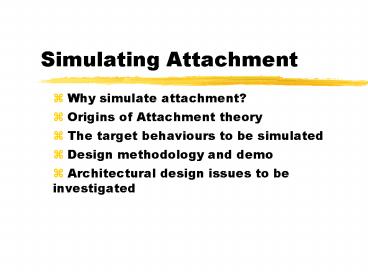Simulating Attachment PowerPoint PPT Presentation
1 / 23
Title: Simulating Attachment
1
Simulating Attachment
- Why simulate attachment?
- Origins of Attachment theory
- The target behaviours to be simulated
- Design methodology and demo
- Architectural design issues to be investigated
2
Why Simulate Attachment?
- It provides a target for a design process - by
building cognitive architectures to perform
certain specific tasks we better understand
architectures generally - Reproducing in simulation specific patterns of
attachment behaviour acts as a test-bed for
developing architectural theories of human
information processing
3
Why Simulate Attachment?
- the developmental trajectory has normative stages
which show representational change - initially only need to simulate limited cognitive
resources - linked with evolutionary, physiological,
anthropological, AI, cybernetic and cross-species
data and theory - can abstract attachment behaviour
4
Origins of Attachment Theory
- John Bowlby, The Attachment Trilogy
- Psychoanalysis, Ethology, Evolutionary Theory and
Cybernetics - Early concentration on long separations, loss,
mistreatment and psychopathology - Changed hospital visiting practice
- Later focus on Individual Differences
5
The target behaviour
- The Strange Situation Experiment arose from
comparing Ugandan and US infant attachment
behaviours - Involves 3 separation/re-union stages
- Each new stage increases the amount of anxiety
they produce - Four patterns of response
- A key pattern is link between home behaviour of
mother and infant and infant behaviour on
re-union in the SS
6
Infant reunion responses in the SS
The target behaviour
- Secure (B type) behaviour
- positive, greeting, being comforted
- Avoidant (A type) behaviour
- not seeking contact, avoiding gaze
- Ambivalent (C type) behaviour
- not comforted, overly passive, show anger
- Disorganised (D type) Behaviour
- totally disorganised and confused
7
Maternal home behaviour prior to the SS
The target behaviour
- sensitivity-insensitivity
- acceptance-rejection
- co-operation-interference
- accessibility-ignoring
- emotional expressiveness
- rigidity(compulsiveness)-flexibility
8
Attachment SS Subgroups vs prior maternal home
behaviour
The target behaviour
9
Design methodology
3 Problems
- Avoiding trivial solutions
- Whether to use data or theory to constrain the
simulation - Non-falsifiability
10
Design methodology
Problem 1 Avoiding trivial solutions
- The simulation is NOT trying reproduce
superficial details of facial expression or body
movement - like a Kismet robot might - It is trying to simulate the causal mechanisms
behind the behaviour, at the level of goals and
action plans within a complete agent in a
multi-agent simulation - BUT an abstraction of the target behaviour in a
broad and shallow complete agent is TOO easy to
reproduce
11
Design methodology
Problem 1 Avoiding trivial solutions
- How to constrain the possible hypotheses space
to exclude trivial solutions? - Assume attachment styles are evolved, adaptive
behaviours
12
Design methodology
Problem 1 Avoiding trivial solutions
- Concentrating on Secure (B type), Avoidant (A
type) and Ambivalent (C type) behaviours as
potentially adaptive responses - Disorganised (D type) Behaviour is unlikely to be
adaptive, but inclusion of this phenomena remains
a possible future constraint
13
Design Methodology
- Taking an evolutionary/adaptive approach the
differences in infant security in the Baltimore
and Uganda studies suggests the following
questions - Are Internal Working Models that are used in
moments of attachment anxiety in part formed in
episodes centred on non-anxious socialisation and
exploration? - What information might infants gain from frequent
episodes of exploration and social interaction
that they use in infrequent episodes of
attachment anxiety? - If my carer wont socially interact on my terms
at all then I am less secure and I must use my
own actions to gain security - If my carer sometimes socially interacts on my
terms then I am less secure and need to
concentrate my efforts in eliciting a response
14
Design methodology
Problem 2 How to combine data, theory and AI
techniques in the simulation - (Mook (1983) In
defense of external invalidity)
- Data and theories to be incorporated in the
simulation - Data from the SS and other attachment studies
- Bowlbys theory
- Distributed control architectures
- Teleoreactive architectures
- H-cogaff architecture
- Theories of Executive Function - SAS
- Machine learning algorithms (RL and ILP)
15
Design methodology
Problem 3 Non-falsifiability
- Duhem, Auxiliary Assumptions
- Popper, Falsifiability and Broad and Shallow
architectures - Lakatos,
- Three kinds of falsification
- Core assumptions and ad hoc assumptions
- Progressive and Degenerative Problem Shifts
16
Design methodology
An unfinished simulation
17
Architectural design issues
- how goals are chosen and represented?
- when goals are chosen how are consequent
behaviours chosen? - whether SS behaviour is deliberative or reactive?
- how skill acquisition, chunking, parsing,
perceptual affordances relate to attachment? - when and how new subsystems come on-line in
attachment stage changes?
18
Architectural design issues
Bowlbys theory
- Behavioural systems from ethology attachment,
exploration, fear and sociability - Stages defined by available control mechanisms
reflex (0-3), fixed action patterns (2-12), goal
correction (9-36), goal corrected partnership
(24- ), (age in months) - Coordination and control mechanisms chaining,
planning, totes, IWMs and language
19
The H-cogaff architecture
Architectural design issues
20
Architectural design issues
Shallice and Burgess - SAS and contention
scheduling
The cogaff schema
SAS
contention scheduling
21
Bowlbys Behaviours represented in an
infant-cogaff architecture
Internal Working Model?
22
Architectural design issues
Development of partnership in planning as
linguistic competence develops
Development of deliberative affordances or
exploration and socialisation driven by
deliberation?
Deliberation in re-union episodes
23
Architectural design issues
- A distributed control system that adapts with
Re-inforcement Learning at each node, has a
non-central, non-symbolic representation, given
by the genes, and undergoes no qualitative change
in representation - A teleoreactive system that adapts using
Inductive Logic Programming, has a simple central
symbolic representation given by the genes that
undergoes qualitative change in representation

